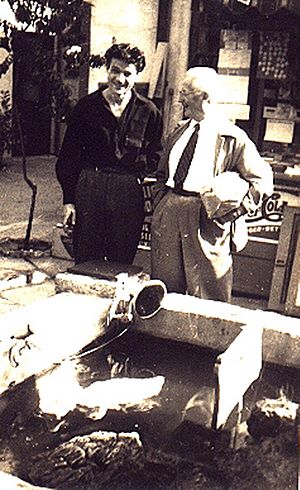Leo Politi facts for kids
Quick facts for kids
Leo Politi
|
|
|---|---|

Leo Politi (left) and Rob Wagner, 1938
|
|
| Born | Atiglio Leoni Politi November 21, 1908 Fresno, California, USA |
| Died | March 26, 1996 Los Angeles, California |
| Occupation | Artist, author |
| Nationality | American |
| Education | National Art Institute (Monza, Italy) |
| Genre | Children's picture books; drawings, paintings |
| Subject | Central America, Mexican-America |
| Literary movement | Multiculturalism, pacifism |
| Notable awards | Caldecott Medal 1950 |
| Spouse | Helen Fontes |
| Children |
|

Leo Politi (born November 21, 1908, died March 26, 1996) was an American artist and writer. He wrote and drew pictures for about 20 children's books. He also created Bunker Hill, Los Angeles (1964), which was for adults. His works often celebrated different cultures. Many of his books were published in both English and Spanish.
Contents
Growing Up and Art School
Leo Politi was born in Fresno, California on November 21, 1908. His parents, Lodovico and Mary, were Italian-American. He had an older sister named Marie Therese.
When Leo was seven, his family moved to Italy. He grew up in his mother's village of Broni, near Milan. Leo loved Broni and always drew pictures of village life. This is where he started to develop his artistic skills.
Later, his family moved to London for a year. In London, Leo explored museums and saw famous paintings by artists like Vincent van Gogh. He enjoyed the city's lively culture.
After London, the Politi family returned to Broni. Leo then received a six-year scholarship to study art. He attended the National Art Institute at the Royal Palace in Monza, near Milan.
Starting His Career
In 1931, at age 22, Leo Politi left Italy and traveled to California. On his journey, he passed through the Panama Canal. He was amazed by the beautiful and unique nature of Central America. He sketched what he saw, and new story ideas began to form in his mind.
He was very interested in the ancient Mayan culture of the region. He developed a special set of colors that he used often in his art. He described these colors as "ochre yellow, burnt sienna and a number of brown tints." These colors reminded him of the warm, earthy feel of the Central American jungle. He also used a bright blue-green for water and sky.
In October 1931, Politi arrived in Los Angeles, California. Two years later, he married Helen Fontes.
Life on Olvera Street
Leo Politi began drawing and painting on Olvera Street in downtown Los Angeles. This was a lively place where he sketched tourists and sold his artwork. He worked alongside other artists who made pottery and weaved.
Politi truly loved Mexican-American people and their traditions. He especially loved drawing children. Drawing Mexican children for magazines and books helped him become a well-known artist.
He painted a mural on Olvera Street called "The Blessing of the Animals." This mural shows a Catholic tradition. It celebrates St. Francis of Assisi's love for all animals. In the mural, people walk their animals to be blessed.
During the 1930s, Politi worked with oils, watercolors, and wood sculptures. He often focused on scenes from Mexican villages, religious events, dancers, and playful children. His art often showed his signature colors: ochre yellow, burnt sienna, and brown.
In 1937, Politi had a special art show in New York City. This show helped him start his career as a children's author and illustrator, focusing on Latin American themes.
His First Books
Leo Politi's first book was Little Pancho, published in 1938. It was an illustrated story about a mischievous Mexican boy on an adventure. This book set him on his path to becoming a children's author.
As World War II approached, Politi started to include themes of peace in his art. He often used his characters, like Pancho, Lupita, and Rosa, to share messages about peace. His artwork showed many different cultures, which was not common at the time.
He also drew pictures for other authors' books. These included The Least One (1941), Aqui se Habla Espanol (1942), and Angelo, the Naughty One (1944). In 1944, he illustrated Stories from the Americas. Around this time, his art style became softer and less dark. This softer style continued in all his future books. Showing different cultures remained a very important theme in his work.
Awards and Recognition
Leo Politi received many honors for his contributions to children's literature.
- In 1950, he won the prestigious Caldecott Medal for his book Song of the Swallows. This award is given to the artist of the most distinguished American picture book for children.
- He was also a Caldecott runner-up for Pedro, the Angel of Olvera Street (1946) and Juanita (1948).
- In 1966, the Catholic Library Association gave him the Regina Medal. This award honors someone who has made a lasting and important contribution to children's literature.
Many places have been named after Leo Politi to honor his work:
- In 1980, a branch of the Fresno Public Library was named after him.
- In 1991, the Leo Politi Elementary School was dedicated in Koreatown, Los Angeles.
- There is also a Leo Politi Square in Echo Park, Los Angeles, where he lived for many years.
Selected Books
- Little Pancho (1938)
- Pedro, the Angel of Olvera Street (1946)
- Juanita (1948)
- Song of the Swallows (1950)
- A Boat for Peppe (1950)
- Little Leo (1951)
- The Butterflies Come (1957)
- Bunker Hill, Los Angeles: Reminiscences of Bygone Days (1964)
- Piccolo's Prank (1965)
- Moy Moy (1960)
- Mr. Fong's toy shop (1978)
- The Three Miracles (1946)
- The Noble Doll (1961)
- Mieko (1969)
- Rosa (1963)
Images for kids


